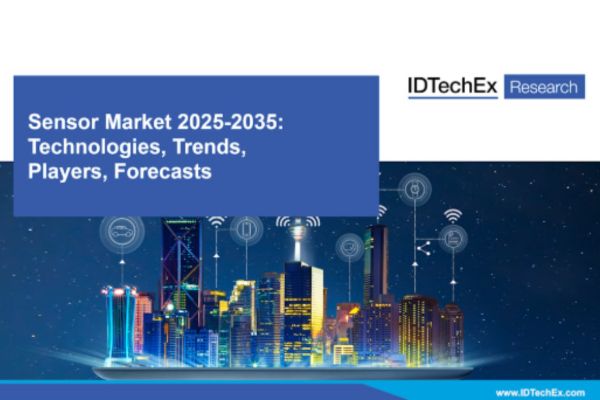IDTechEx predicts that the global sensor market will exceed US$250B by 2035. Yet despite its established age and size, this market remains under pressure to adapt to new end-user needs. Based on the research from IDTechEx’s report, “Sensor Market 2025-2035: Technologies, Trends, Players, Forecasts“, this article outlines which trends are redefining the market landscape today.
Smaller, smarter and more efficient
Sensor technology comes in many shapes and sizes, designed to measure a wide range of metrics for a host of different applications. There are sensors to collect data from almost all physical parameters: motion, magnetic field, current, temperature, force-light intensity – the list goes on. These miniaturized components are everywhere, from our smart-phones and home appliances to within cars, factories, and satellites.
Yet despite the diversity of the sensor market, there are some unifying trends in technology innovation. Firstly, there is ongoing development in making sensors smaller and less power-hungry. As the ‘real-estate’ within devices becomes more precious, further miniaturization continues to be a vessel for differentiation. However, at the same time, there is a pressure for sensors to be capable of measuring even more metrics than currently available, and with improved performance characteristics. This could be increased sensitivity or selectivity – or leveraging the data processing power of AI.
Sensor manufacturers are anticipated to release smaller, smarter and more efficient products in the years ahead. The ambition of optimizing SWAP (Size, Weight and Power) continues to drive the industry forward from electronics manufacturing giants and start-ups alike.
Evolving to the needs of growing markets
The sensor market is evolving to meet the needs of some core growing industries. Four of the most impactful are future mobility, industrial IoT, healthcare, and consumer electronics.
Firstly, within mobility, there is a big shift from ICE (internal combustion engine) vehicles towards electric vehicles. This comes with new demands for battery management systems and as a result, sensors. Yet beyond electrification, sensors are also key enablers of autonomy – and perhaps even driver monitoring.
Secondly, the Internet of Things (IoT) has, in part, failed to launch, yet as edge computing capabilities are improving, there is a resurgence of interest in industrial IoT. IIoT is anticipated to specifically boost demand for edge sensing – and use cases to optimize resources, improve efficiency and revamp inventory management.
Figure 2- Sensor market roadmap. Source IDTechEx
Next, healthcare is going digital, with telemedicine and smarter medical devices looking to alleviate the burden of aging populations, widespread chronic disease, and labor shortages. Reducing pressures on hospital staffing could partly be met with remote patient monitoring. As such, there is ongoing investment to commercialize new sensor technologies and wearables to report on patients’ vital signs, activity levels, and quality of life at home.
Finally, some players are preparing for a revolution in consumer electronics. More specifically, a shift away from a smart-phone centric experience towards smart glasses and extended reality. There is a still a way to go in improving the optics enough to make eye-worn electronics more fashionable, but if mass adoption does follow so will a need for different HMI solutions. Demand for sensors that can maintain immersiveness but fulfill the functions of buttons and touchscreens could well be set to rise. This could even include brain computer interfaces to analyse our intentions.
Responding to global crises
As well as getting smaller and smarter and meeting the specific needs of growing markets, sensors can also play a role in responding to global crises. These include challenges in energy, security, and climate change.
The high costs associated with energy uncertainty only increases the pressure on sensors to be ultra-low power, or even powered by energy harvesting methods. More so, however, is adding to the drive for sensor networks to enable resource optimization within IoT systems.
Regarding security risks, the vulnerability of cloud connected sensor solutions has become a greater concern. In its place is an appreciation of the enhanced robustness to cyber threats offered by edge sensing.
As for climate change and sustainability, there is a need for the manufacturing of electronics including sensors, to be greener but also the applications. Moreover, sensors can play a vital role in collecting climate and weather data which are increasingly important in improving forecasting and early warning systems.
Conclusions and Market Outlook
Many factors are at play dictating the future direction of the sensor market. From a technology perspective there is an overarching effort to make components smaller, lower in power consumption and higher in performance. Growing markets in mobility, industrial IoT, healthcare, and consumer electronics are set to demand sensors which can collect newly relevant sources of data – whilst meeting the needs of the respective industry regulators and OEMs. Finally, the sensor market is not impervious to the global challenges of energy uncertainty, climate change, and cyber-security. These crises create both hurdles and opportunities for the next generations of sensor products.
Individual sensor solutions may only be shaped by a sub-set of the drivers identified in this article, but as a whole, they represent the key trends molding the next ten years of the sensor market and beyond.
IDTechEx’s report, “Sensor Market 2025-2035: Technologies, Trends, Players, Forecasts” critically evaluates key sensor applications in industrial IoT, environmental IoT, and consumer IoT markets. The report provides a comprehensive overview of the global sensor market, with insights and critical analysis of emerging sensor application markets in future mobility, IoT, wearable technology, printed electronics, and edge computing. The report contains ten-year global sensor market forecasts from 2025-2035, segmented by sensor technology, including semiconductor sensors, gas sensors, automotive and aerospace sensors, biosensors, sensors for future mobility, quantum sensors, image sensors, and silicon photonic sensors.


















